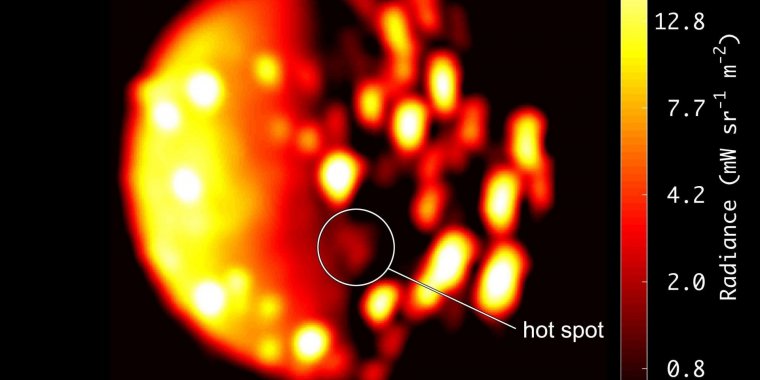| News / Space News |
NASA Juno data indicate another possible volcano on Jupiter moon Io
Data collected by NASA's Juno spacecraft using its Jovian InfraRed Auroral Mapper (JIRAM) instrument point to a new heat source close to the south pole of Io that could indicate a previously undiscovered volcano on the small moon of Jupiter.

This annotated image highlights the location of the new heat source close to the south pole of Io. The scale to the right of image depicts of the range of temperatures displayed in the infrared image. Higher recorded temperatures are characterized in brighter colors - lower temperatures in darker colors. Image credit: NASA/JPL-Caltech/SwRI/ASI/INAF/JIRAM
"The new Io hotspot JIRAM picked up is about 200 miles (300 kilometers) from the nearest previously mapped hotspot," said Alessandro Mura, a Juno co-investigator from the National Institute for Astrophysics in Rome. "We are not ruling out movement or modification of a previously discovered hot spot, but it is difficult to imagine one could travel such a distance and still be considered the same feature."
The Juno team will continue to evaluate data collected on the Dec. 16 flyby, as well as JIRAM data that will be collected during future (and even closer) flybys of Io.
Past NASA missions of exploration that have visited the Jovian system (Voyagers 1 and 2, Galileo, Cassini and New Horizons), along with ground-based observations, have located over 150 active volcanoes on Io so far. Scientists estimate that about another 250 or so are waiting to be discovered.
Juno has logged nearly 146 million miles (235 million kilometers) since entering Jupiter's orbit on July 4, 2016.
Juno launched on Aug. 5, 2011, from Cape Canaveral, Florida. During its mission of exploration, Juno soars low over the planet's cloud tops -- as close as about 2,100 miles (3,400 kilometers).
During these flybys, Juno is probing beneath the obscuring cloud cover of Jupiter and studying its auroras to learn more about the planet's origins, structure, atmosphere and magnetosphere. (NASA)
YOU MAY ALSO LIKE

